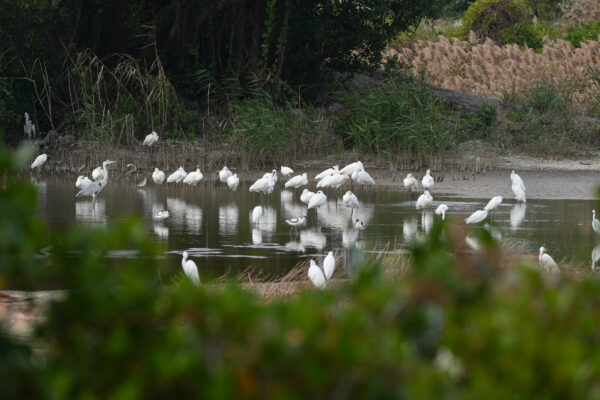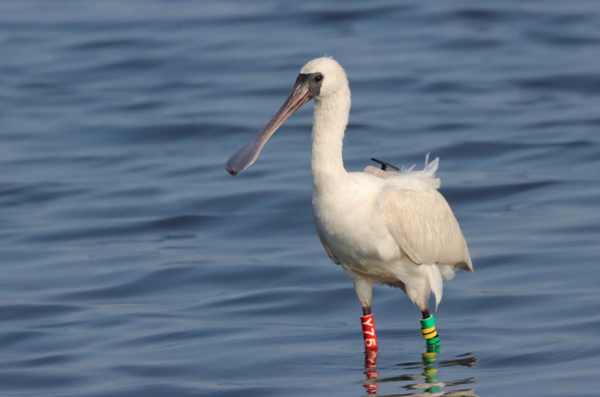-
Global population of Black-faced Spoonbill continues to break new record
© Jay Kong/HKBWS Coordinated by EAAFP Partner, The Hong Kong Bird Watching Society (HKBWS), the International Black-faced Spoonbill Census 2023 was conducted from 6th to 8th January 2023. Global population of Black-faced Spoonbills (BFSs) reaches another record high of 6,603, a rise of 7.2% (i.e. 441 individuals) from last year. However, 299 individuals were recorded in the Deep Bay area across Hong Kong and Shenzhen, which is 70 individuals less compared to last year. The number shows a decline of 11% and 19% from 2021 and 2022 respectively. Steady growth in Taiwan, Mainland China and Korea while moderate decline in Japan and almost 20% drop in Deep Bay The census covered about 130 sites all over the world. Taiwan, Mainland China and the Republic of Korea are the major regions which attribute to the growth in the overall population. Taiwan remains the largest congregation site with 4,228 individuals comprising 64% of the global population. The year-on-year growth is 10.6%. In Mainland China, 1,307 individuals and 15.1% year-on-year growth were recorded. The number comprised 20% of the global population. In Ro Korea, the number of BFS reaches 54 individuals with an increase of 45.9%, i.e. 17 individuals. Contrarily, in Japan 610 individuals are recorded which shows a decline of 10.7% from last year, i.e. 73 individuals less. The results this year shows that the global population of Black-faced Spoonbills has increased steadily. The numbers in Taiwan and Mainland China have been setting new records in recent years, which suggests the conditions in those habitats are favourable for a larger number of Black-faced Spoonbills to stay or to gather. Favourable conditions may refer to a safe environment, and sufficient food sources in nearby feeding grounds. The decline in Japan might be related to the loss of stopover sites and the outbreak of bird flu, according to local experts. In Deep Bay area, 299 individuals were recorded, which is the second lowest record in the last decade. Compared to last year, there were 70 individuals les, that is 19% decline. Having reached its record high of 462 individual in 2010, the number of BFS in Deep Bay has not advanced since then and remained above 300 from 2016 until it dropped to 299 this year. The result this year is worrying. Fig. 1 Black-faced Spoonbill Census results 1989-2023 © HKBWS Fig. 2 Black-faced Spoonbill Population size and distribution © HKBWS Fig. 3 Black-faced Spoonbill Census results regional breakdown 1989-2023 © HKBWS The problem of habitat degradation must be confronted, and conservation should be prioritized in the Northern Metropolis Development Strategy The decline in the number of Black-faced spoonbills in Deep Bay area is alarming to Hong Kong. Black-faced Spoonbills mainly forage in the intertidal mudflats of Deep Bay, shallow waters in Gei Wai, and drained fishponds. As the Ramsar Wetland in Mai Po Inner Deep Bay is relatively adequately protected by law, these habitats can be maintained in relatively good conditions. However, the habitats outside the nature reserve are facing different threats. Without immediate measures, they may become unsuitable for Black-faced Spoonbills to loaf and feed. For instance, the expansion of mangroves, including the invasive species Sonneratia caseolaris, continues to eat up the mudflats resulting in a reduction in the habitat available to Black-faced Spoonbills. On the other hand, nearly 30% of the fishpond wetlands and the buffer zones in Deep Bay are hoarded by real estate developers or held privately. These lands have been abandoned or the land use has been altered, which continuously causes habitat degradation in the Deep Bay area. If proactive conservation and management actions are not taken immediately, there is a risk for losing these important winter habitats of the Black-faced Spoonbills’. In order to protect the Black-faced Spoonbill, many countries and cities put great effort into different conservation actions in the past 30 years, and finally the decline of the species is successfully reversed. "It is especially important to establish comprehensive protection laws, long-term conservation strategies and good land use planning, which can restore endangered species and even biodiversity around the world." Mr. Yu Yat-tung, Director of The Hong Kong Bird Watching Society, continued, "The future of the Deep Bay wetlands is determined by the conservation and planning of the Northern Metropolis Development Strategy. To protect the ecological integrity of this internationally important wetland, the Northern Metropolis must comply with the guidelines to protect "Wetland Conservation Area" and "Wetland Buffer Area". The wetland conservation park system must fully cover the "Inner Deep Bay and Shenzhen River catchment area" Important Bird Area recognized by BirdLife International, and ensure them to be protected by stricter laws and regulations; also a management model that is people and ecology oriented must be applied.” Hong Kong is responsible for the proper protection of wetlands and biodiversity, the maintenance of the important ecological corridors for migratory birds, and the assistance to China in fulfilling its obligations under the “Convention on Biological Diversity” and the “Convention on Wetlands”. The Hong Kong Bird Watching Society hopes that the Northern Metropolis can practice "ecological priority", through proper management and conservation of the Deep Bay wetlands, turn crisis into opportunity, and maximize the benefits of bird conservation. Fig. 4 Trend of Black-faced Spoonbill population in Deep Bay © HKBWS About The International Black-faced Spoonbill Census Black-faced Spoonbill is listed as "Endangered" on the International Union for Conservation of Nature's (IUCN) Red List of Threatened Species. The International Black-faced Spoonbill Census takes place every January ever since it was first launched in 1994. During Census 2023, more than 200 veteran birdwatchers, conservationists, researchers and ornithologists were mobilized to record the number of wintering Black-faced Spoonbills at about 130 sites. Reposting of news article from Hong Kong Bird Watching Society with permission, original article (link). Learn about EAAFP Black-faced Spoonbill Working Group: https://www.eaaflyway.net/black-faced-spoonbill-working-group/
Continue reading -
Juvenile distribution pattern and conservation of the endangered Black-faced Spoonbill
EAAFP Small Grant Fund Project by Chi Yeung Choi, Jimmy Duke Kunshan University The individually-marked Black-faced Spoonbill ‘Y75’, was one of the twenty individuals tagged with satellite tracker. Y75 was ringed on Chilsando, Korea, 2nd July 2020, then seen on Taiwan Island 26th October 2020 ©Yi-Cheng Chen Among the threatened migratory waterbird species in the East Asian–Australasian Flyway (EAAF), the Black-faced Spoonbills (BFS) Platalea minor stands out as one of the very few species showing a recovering trend, from just a few hundred to more than 6,000 over the last 30 years partly due to the extensive conservation effort and BFSs’ ability to utilise artificial wetlands. Over the years, the foraging ecology (Yu et al. 2004a), habitat use (Yu et al. 2004b), threats (Sung et al. 2018) and migration routes (Wood et al. 2013) of BFS have been studied in various locations. Yet relatively little is known about their movement ecology, especially juveniles. In this proposed project, we aim to quantify the wintering distribution pattern of juvenile BFS in their first boreal winter using GPS-GSM transmitters. The ultimate goal is to identify the key regions where juvenile BFS winter and safeguard these areas for the continuous recovery of this endangered population. In 2020 June and July, juvenile BFS were captured near their nests from breeding islands along the west coast of South Korea. Measurements were recorded and unique colour ring combination on the tibia of BFS was used for individual marking. Solar-powered GPS/GSM satellite trackers (19g or 1.3% of juvenile BFS body weight) were deployed to the back of spoonbills using backpack method. Twenty juvenile BFS were captured and equipped with satellite trackers on their back during June and July 2020. Five individuals died without leaving Korea while one individual with tracker failure. In the remaining 14 individuals that left Korea and migrated, 10 of them (71.4%) spent their first winter in mainland China, two (14.3%) on Taiwan Island and two (14.3%) in southeast Japan. Among the 10 individuals that spent their first winter in mainland China, three individuals (30%) stayed in Jiangsu province and another three individuals (30%) in Zhejiang province, while two individuals (20%) resided in Guangdong, one individual in Hainan and one in Anhui. About half of these 14 wintering sites were protected. Among the 14 individuals that left Korea, the one that spent its first winter at the highest latitude (Jiangsu Lianyungang) and the one at the lowest latitude (Hainan) eventually died during their first winter. Our results showed the importance of the coastal wetlands in mainland China, especially those along the Jiangsu, Shanghai and Zhejiang coasts, for juvenile BFS during their southward migration and first winter. All tracked individuals that flew across the Yellow Sea from the west coast of Korea made their first landfall in coastal wetlands along the Jiangsu, Shanghai and Zhejiang coasts. The tracking results indicated the importance of coastal wetlands in Zhejiang Zhoushan, Hangzhou Bay and Wenzhou Bay to juvenile BFS. Moreover, two of the tracked birds that migrated successfully to mainland China for their first winter, eventually died at Lianyungang and Hainan. The cause of mortality was unclear but 35% of tracked BFS died within 6 months after released, showing the challenges that young BFS faced in their early years. It is important to record the potential cause of mortality and mitigate those threats to ensure the continuous population recovery of this endangered species. This project laid the important foundation for further tracking projects that will help researchers to determine the potential drivers for the observed juvenile wintering distribution pattern. This could be achieved by combining the tracking data with findings with annual synchronized censuses. Moreover, the tracking data could also be used to evaluate the extent to which protected areas along the flyway encompass the full range of habitats used by BFS during non-breeding season. The southward migration pathway and wintering distribution of satellite-tracked Black-faced Spoonbills in 2020 References: Sung Y-H, Tse IW-L, & Yu Y-T. 2018. Population trends of the Black-faced Spoonbill Platalea minor: analysis of data from international synchronised censuses. Bird Conservation International, 28(1), 157-167. Wood, C., Tomida, H., Jin-Han, K., Lee, K.S., Cho, H.J., Nishida, S., Ibrahim, J., Hur, W.H., Kim, Yu YT, & Swennen C. 2004a. Feeding of wintering Black-faced Spoonbills in Hong Kong: When and how long? Waterbirds, 27(2), 135-140. Yu YT, & Swennen C. 2004b. Habitat use of the Black-faced Spoonbill. Waterbirds, 27(2), 129-134. The project was funded through the 2020 EAAFP WG/TF Small Grant Fund. View the report, Click here.
Continue reading




